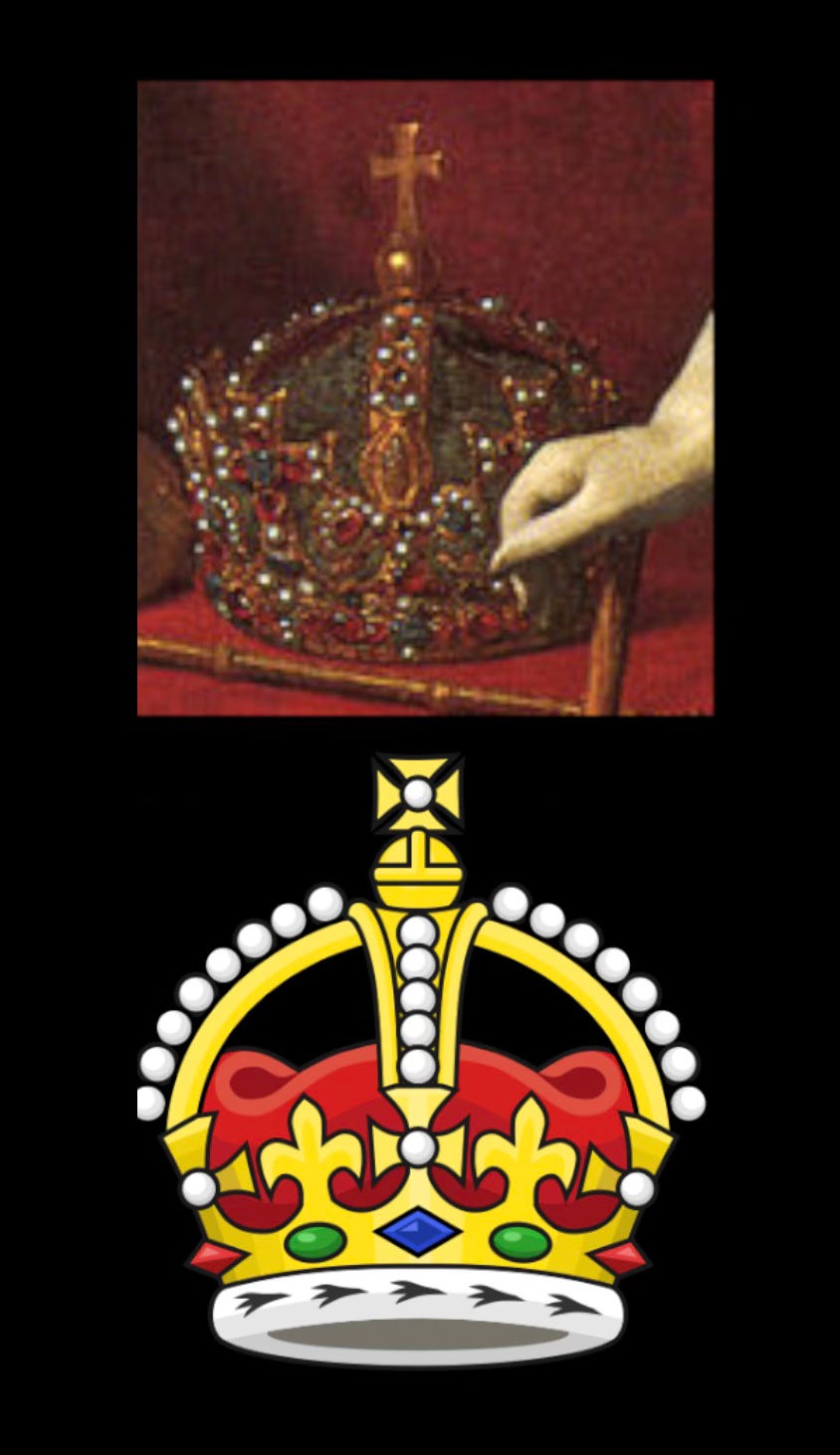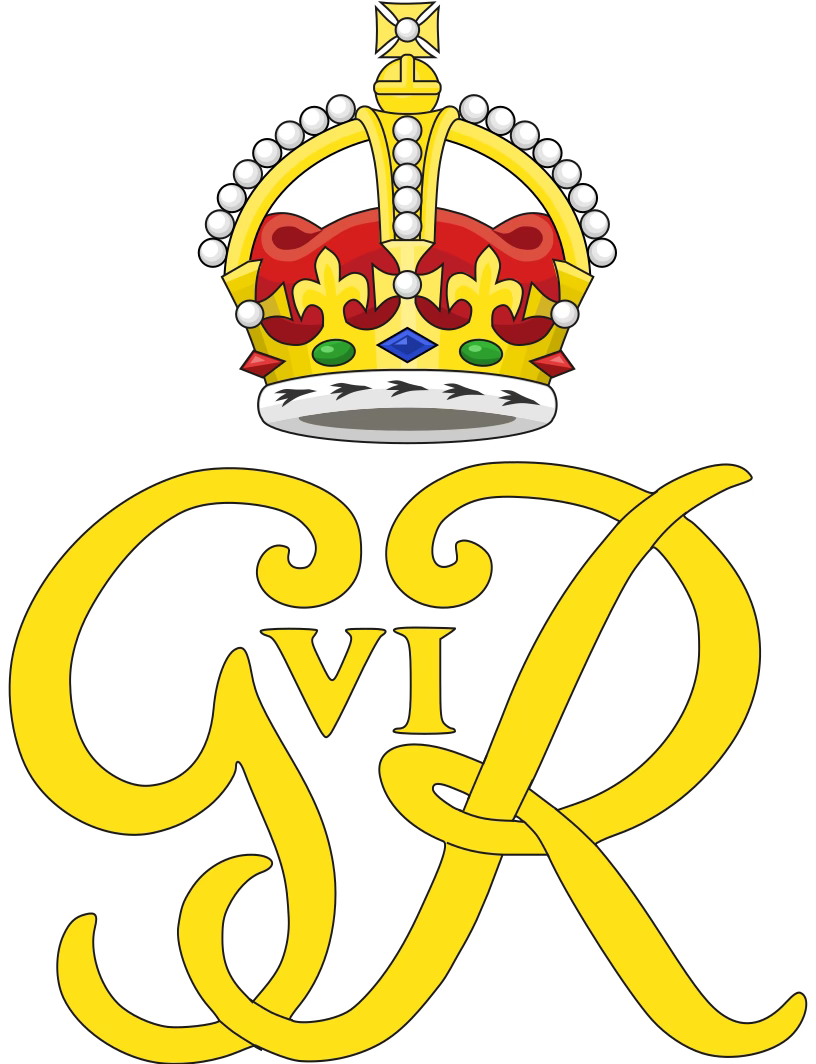The Power of Symbolism: The Tudor Crown's Revival by Charles III
THIS REGALIA HAS IT ALL; HISTORY, MYSTERY AND RESURRECTION
Long ago, our favorite dynasty had its very own crown, and just like its namesake, the Tudor Crown’s story is filled with magnificence, drama, and tragedy. Officially named 'The Tudor Crown Imperial' or 'Henry VIII’s Crown,' this forgotten symbol has emerged into the spotlight once more. Read on to uncover the fascinating secrets of this enigmatic crown of shadows.

The Tudor Crown’s story has captivated me for years, so imagine my delight when King Charles III chose its depiction for his royal cypher upon ascending the throne. This act marked a significant change from his mum’s previous branding of the monarchy, which stood for 70 years! Her late Majesty’s depiction reflected St Edward’s crown, the hallowed centerpiece of the Crown Jewels, since Edward I was believed to been crowned with the original in 1274. In contrast, the Tudor crown will never be worn by a monarch due to its tragic history (more on that later).

In part one of this “Power of Symbolism” series I covered Henry Tudor's creation of the iconic gold Sovereign, England's first pound coin. You can read that popular article here. In part two, I explored the legacy of the incomparable Tudor rose that one is here
This post is different in that this symbol, The Tudor Crown, is not definitively credited to Henry VII. I just whole heartily believe he commissioned it, and it could very well be his creation. While there is no historical evidence to support this, I hope to convince you otherwise. If not, you know I’d love to hear your thoughts in the comments ;-)
Let’s dig into:
Where the crown is today
Why I believe it was commissioned by Henry VII
The tragedy of it’s destruction
Why King Charles III might have chosen it
The Tudor Crown Today
The "Tudor Crown Imperial", named for its closed arches, is currently housed at Hampton Court Palace. But Amy, you just alluded to the crown’s non existence?! Yes, that’s because the one on display at HCP is actually a replica! This new Tudor Crown was crafted with painstaking detail in 2012 by the former crown jeweler, Harry Collins. It’s as close as we can get to the real deal. This replica is made from silver gilt—solid silver with a layer of gold over it—making it more durable and much lighter than the 16th-century version. The original was crafted from a whopping 84 ounces of gold! Can you imagine the weight of that? Definitely check out this masterpiece if you are planning a visit to the palace this year
The Mystery of the Original Crown
No one knows for sure if it was King Henry VII or his son Henry VIII who actually commissioned the original crown, but my money is on Henry VII, and I'll give you two reasons why:
1. Henry VII’s Talent for Symbolism: Despite his reputation for being close- fisted, Henry VII knew how to show off. He was a master at displaying his power and wealth and, according to Tracy Borman, he also looked the part. The King reportedly spent the equivalent of three million pounds on his appearance in his first two years on the throne! While he was wearing these sumptuous clothes and jewels he also commissioned opulent residences like Richmond Palace and greatly expanded Greenwich Palace. It makes sense, to me, that he would have been the mastermind behind designing a crown of such magnitude: 344 precious gemstones, including 233 pearls, 21 sapphires, 2 emeralds, and 27 diamonds. Don’t you agree?
2. Henry VII on Coins: As I wrote in part one of this series, Henry VII was the first English monarch to be pictured wearing an "Imperial" style crown (with its signature arches) on his coins, most notably when he created the gold Sovereign in 1489. This massive gold coin, almost a half-ounce of 23-carat gold, was definitely a statement piece. The design of the Tudor Crown was likely an extension of Henry’s intended message: he was a world-class ruler more closely related to an emperor than a mere king.
The Tragic Destruction
In 1649, following the abolition of the monarchy and the unprecedented execution of King Charles I, the original Tudor Crown was destroyed. All 344 precious stones were sold off, and the 84 ounces of gold were melted down to make coins. Unfortunately, we’ll never have a portrait of Henry VII or VIII wearing it in all of its glory; however, we do have records of Henry VIII donning it during his reign on the feast of the Epiphany (which takes place on January 6).
Sadly, the crown was not recreated during the restoration of the monarchy when King Charles II was commissioning all new regalia for his 1661 coronation. This surprised me since his father famously displayed it in his portrait posted above. Instead, Charles II recreated St Edward’s Crown, which had been included in the destruction of royal regalia. The Tudor Crown Imperial wasn’t seen again until 2012 when Harry Collins created the stunning reproduction (you’ll have to visit to see it).

King Charles III's Choice
Did you watch King Charles III’s coronation on May 6th, 2023? If so, you would have witnessed the exquisite St Edward’s Crown being placed upon his head at the moment of his coronation. Monarchs only wear this hallowed piece of regalia once in their lifetime, on that special occasion. His Majesty also wore the recognizable Imperial State Crown, featured prominently in Queen Elizabeth II’s coronation portrait. This mesmerizing crown is my second favorite, after the Tudor Crown, due to the captivating historical gems that adorn it; the Black Prince’s Ruby, the Stuart Sapphire, and the whopping 317 carat Cullinan II Diamond. I wonder if, had it survived, the Tudor Crown would be used in its place.
Why the Tudor Crown?
What inspired King Charles III to choose the Tudor Crown for his royal cypher?
Could it be a tribute to his grandfather, King George VI, who used it on his royal cypher prior to Queen Elizabeth II’s reign?
Is it to symbolize the ushering in of a new era?
Does His Majesty also have an affinity for the Tudors like we do?
We can only wonder, but hopefully, it will spark new interest in the history of the Tudor dynasty as well as the crown itself.
So, what do you think about King Charles III’s choice to change the royal cypher? This decision has lead to adjustments on public buildings, police and military uniforms, post boxes and state documents. Let me know your thoughts in the comments!

I can't wait to start my next article in the "The Power of Symbolism" series where I'll explore another iconic symbol like the previous three—symbols we often overlook as Henry VII's ingenious creations (or ones we suspect are his).
Until then,
Fair thee well
~Amy
! p.s. Don’t forget to check out my Youtube here I have videos up that will complement the content in the FairTheeWell newsletter, including one coming soon of this article and a popular one of the Sovereign Coin. I am trying to get Henry VII some long overdue attention on that platform and I am having a lot of fun putting in the effort to make great quality, engaging videos.









You are a magnificent writer !!! 🏵️
Thank you for sharing this wonderful piece of regalia! I used to work very close to Hampton Court Palace and we would take groups of children there every summer. I was always captivated by the crown: though 'only' a replica, it seemed far too precious and nationally-significant to be displayed as casually as it was. I love the history of objects, and so it is interesting to hear about the way Charles III has affiliated himself with this distant relative. I wonder, too, what he is trying to communicate about his kingship...!